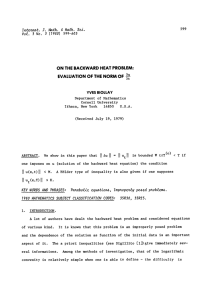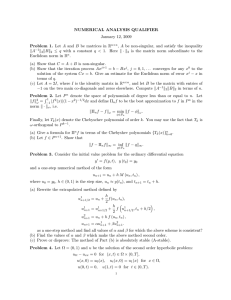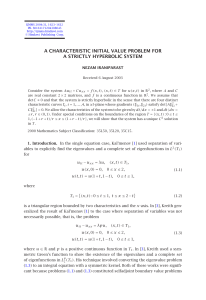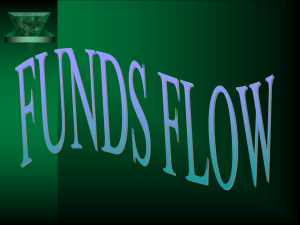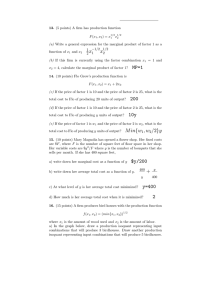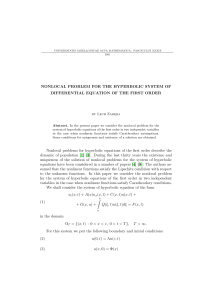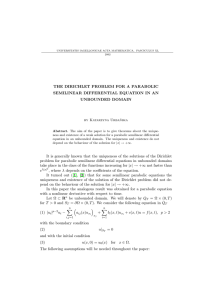POINTWISE CONTROLLABILITY AS LIMIT OF INTERNAL CONTROLLABILITY FOR THE WAVE EQUATION
advertisement
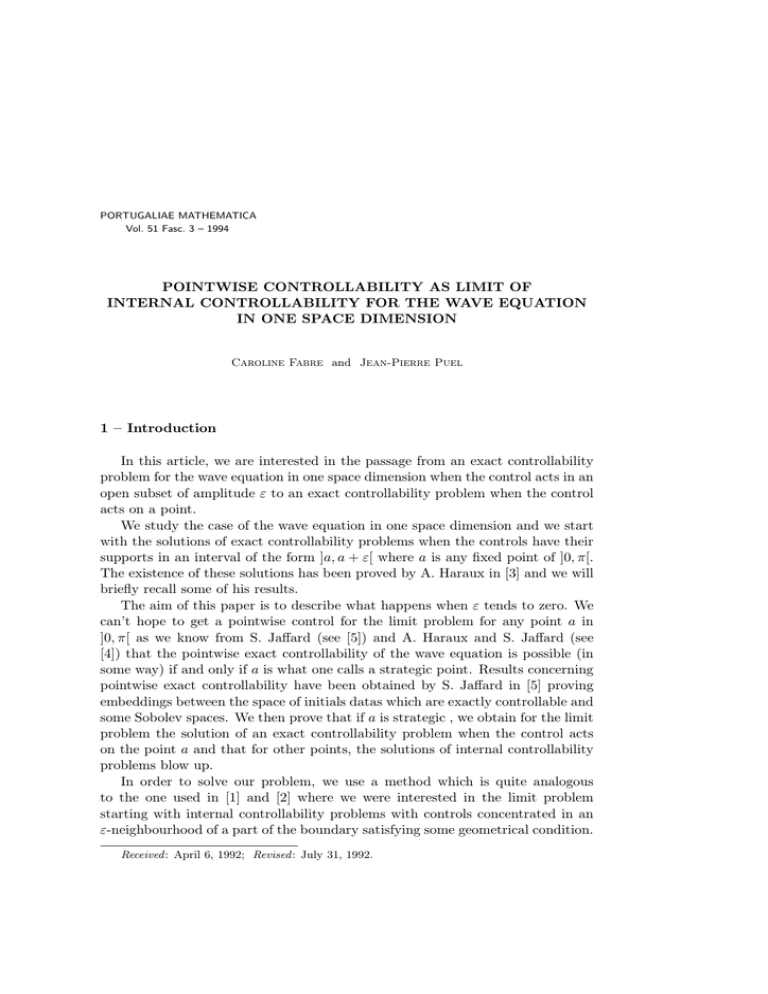
PORTUGALIAE MATHEMATICA Vol. 51 Fasc. 3 – 1994 POINTWISE CONTROLLABILITY AS LIMIT OF INTERNAL CONTROLLABILITY FOR THE WAVE EQUATION IN ONE SPACE DIMENSION Caroline Fabre and Jean-Pierre Puel 1 – Introduction In this article, we are interested in the passage from an exact controllability problem for the wave equation in one space dimension when the control acts in an open subset of amplitude ε to an exact controllability problem when the control acts on a point. We study the case of the wave equation in one space dimension and we start with the solutions of exact controllability problems when the controls have their supports in an interval of the form ]a, a + ε[ where a is any fixed point of ]0, π[. The existence of these solutions has been proved by A. Haraux in [3] and we will briefly recall some of his results. The aim of this paper is to describe what happens when ε tends to zero. We can’t hope to get a pointwise control for the limit problem for any point a in ]0, π[ as we know from S. Jaffard (see [5]) and A. Haraux and S. Jaffard (see [4]) that the pointwise exact controllability of the wave equation is possible (in some way) if and only if a is what one calls a strategic point. Results concerning pointwise exact controllability have been obtained by S. Jaffard in [5] proving embeddings between the space of initials datas which are exactly controllable and some Sobolev spaces. We then prove that if a is strategic , we obtain for the limit problem the solution of an exact controllability problem when the control acts on the point a and that for other points, the solutions of internal controllability problems blow up. In order to solve our problem, we use a method which is quite analogous to the one used in [1] and [2] where we were interested in the limit problem starting with internal controllability problems with controls concentrated in an ε-neighbourhood of a part of the boundary satisfying some geometrical condition. Received : April 6, 1992; Revised : July 31, 1992. 336 C. FABRE and J.-P. PUEL We will have to prove some results concerning the behavior of weak solutions of the wave equation in an interval of length ε. As they are independent of the exact controllability problem, we state them in a first section. After recalling the results of A. Haraux mentioned above, we will prove an inverse inequality which will give us the estimates on the internal controls in the case of a strategic point which are necessary to pass to the limit when the amplitude ε tends to zero. We then end up with the limit problem. 2 – Behavior near a point We consider here the weak solutions of the wave equation in Ω×]0, T [ where Ω =]0, π[. Let h, u0 , u1 be elements of L1 (0, T ; H −1 (Ω)), L2 (Ω) and H −1 (Ω) and let u be the solution of 00 2 u − ∂ u = h in Ω × [0, T ] u = 0 in ∂Ω × [0, T ] (2.1) u(0) = u0 , and u0 (0) = u1 . We recall that u ∈ C(0, T ; L2 (Ω)) ∩ C 1 (0, T ; H −1 (Ω)) and that such solutions of the wave equation can be defined by transposition (we refer to [6] for more details). We denote by Ω² the interval ]a, a + ε[, where a is a point of ]0,π[ and we will take ε < π − a. For simplicity, we denote by ∂u the derivative with respect to the space variable x of a function u. The main results of this section concern the regularity of u(a,t) where u is a weak solution of (2.1) and a is any point of ]0, π[ and the behavior of the L2 -norm of u in an ε-neighbourhood of a. These results are gathered in the following Theorem 2.1. There exists a constant c > 0 and a real number ε0 > 0 such that for every ε ≤ ε0 , and for every (h, u0 , u1 ) in L1 (0, T ; H −1 (Ω)) × L2 (Ω) × H −1 (Ω), the solution u of (2.1) satisfies: u(a, t) ∈ L2 (0, T ) , (2.2) and we also have an estimate such as 1 (2.3) ε Z T 0 Z Ωε u2 (x, t)dxdt ≤ c(||h||2L1 (0,T,H −1 (Ω)) + ||u0 ||2L2 (Ω) + ||u1 ||2H −1 (Ω) ) . Proof: We introduce v = ∆−1 u with Dirichlet conditions on the boundary. 337 INTERNAL CONTROLLABILITY FOR THE WAVE EQUATION The function v is a solution of v 00 − ∂ 2 v = f in Ω × [0, T ] v = 0 in ∂Ω × [0, T ] (2.4) v(0) = v 0 and v 0 (0) = v 1 , with initial data v(0) = v 0 , v 0 (0) = v 1 and with a right hand side f satisfying 0 v = ∆−1 u0 ∈ H 2 (Ω) ∩ H01 (Ω) v 1 = ∆−1 u1 ∈ H01 (Ω) f = ∆−1 h ∈ L1 (0, T ; H01 (Ω)) . and it is sufficient to prove the Theorem 2.2. There exists a constant c > 0 and a real number ε0 > 0 such that for every ε ≤ ε0 , and for every (f, v 0 , v 1 ) in L1 (0, T ; H01 (Ω)) × (H 2 (Ω) ∩ H01 (Ω)) × H01 (Ω), the solution v of (2.4) verifies: ∂ 2 v(a, .) ∈ L2 (0, T ), ∂v 0 (a, .) ∈ L2 (0, T ) (2.5) and the mapping (2.6) L1 (0, T ; H01 (Ω)) × (H 2 (Ω) ∩ H01 (Ω)) × H01 (Ω) → L2 (0, T ) × L2 (0, T ) (f, v 0 , v 1 ) 7→ (∂ 2 v(a, .), ∂v 0 (a, .)) is linear continuous. Furthermore, we have (2.7) 1 ε Z T 0 Z Ωε [(∂ 2 v)2 (x, t) + (∂v 0 )2 (x, t))]dxdt ≤ c(||f ||2L1 (0,T,H 1 (Ω)) + ||v 0 ||2H 2 (Ω)∩H 1 (Ω) + ||v 1 ||2H 1 (Ω) ) . 0 0 0 Proof: Using a density argument, it is sufficient to prove this result for a right hand side f in D((0, T ) × Ω). The function w = v 0 is then a solution with finite energy of (2.8) w00 − ∂ 2 w = f 0 in Ω × [0, T ] w = 0 in ∂Ω × [0, T ] w(0) = v 1 , and w 0 (0) = ∂ 2 v 0 . 338 C. FABRE and J.-P. PUEL In order to use the multiplier method, we introduce a function ρ element of W 1,∞ (a, 1) and we denote by Qa =]a, 1[ × ]0, T [. Multiplying the equation satisfied by w by ρ∂w, we get Z 2 00 (w − ∂ w)∂wρdxdt = Qa Z f 0 ∂wρdxdt . Qa But, by integrations by parts, we have Z w00 ∂wρdxdt = Qa Z 1 ∂w(x, T )w0 (x, T )ρ(x)dx − a 1 + 2 = Z Z 1 w02 ∂ρdxdt + 2 Qa 1 Z T Z 1 + 2 Z 1 v 002 ∂ρdxdt + 2 Qa Z a w02 (a, t)ρ(a)dt ∂v (x, T )∂ v(x, T )ρ(x)dx − a ∂w(x, 0)w 0 (x, 0)ρ(x)dx 0 2 0 1 T Z 1 ∂v 0 (x, 0)∂ 2 v(x, 0)ρ(x)dx a v 002 (a, t)ρ(a)dt . 0 As v 00 = f + ∂ 2 v and f (0) = f (T ) = 0, we finally obtain (2.9) Z w00 ∂wρdxdt = Qa Z 1 a 1 + 2 + Z ∂v 0 (x, T )∂ 2 v(x, T )ρ(x)dx − Z Z 1 f (x, t)∂ρ(x)dxdt + 2 Qa 2 Z 1 ∂v 0 (x, 0)∂ 2 v(x, 0)ρ(x)dx a (∂ 2 v)2 (x, t)∂ρ(x)dxdt Qa f (x, t)∂ 2 v(x, t)∂ρ(x, t)dxdt + Qa 1 + 2 Z T 2 2 (∂ v) (a, t)ρ(a)dt + 0 Z T 1 2 Z T f 2 (a, t)ρ(a)dt 0 f (a, t)∂ 2 v(a, t)ρ(a)dt . 0 On the other hand, we have (2.10) 1 ∂ w(x, t)∂w(x, t)ρ(x)dxdt = − 2 Qa Z 2 Z (∂v 0 )2 (x, t)∂ρ(x)dxdt Qa 1 + 2 Z T 0 (∂v 0 )2 (a, t)ρ(a)dt INTERNAL CONTROLLABILITY FOR THE WAVE EQUATION and (2.11) Z Qa f (x, t)∂w(x, t)ρ(x)dxdt = − Z Qa =− Z Qa 1 2 Z + Z 0 = f (x, t)∂w 0 (x, t)dxdtρ(x)dxdt f (x, t)∂(f + ∂ 2 v)(x, t)ρ(x, t)dxdt f 2 (x, t)∂ρ(x)dxdt + Qa + Z + Z 339 1 2 Z T f 2 (a, t)ρ(a)dt 0 2 ∂ v(x, t)∂f (x, t)ρ(x, t)dxdt Qa f (x, t)∂ 2 v(x, t)∂ρ(x)dx Qa T f (a, t)∂ 2 v(a, t)ρ(a)dt . 0 Taking into account (2.9), (2.10) and (2.11), we then obtain (2.12) Z Z Z 1 T 1 T 2 2 1 0 2 (∂v ) (a, t)ρ(a)dt + (∂ v) (a, t)ρ(a)dt = − (∂ 2 v)2 (x, t)∂ρ(x)dxdt 2 0 2 0 2 Qa Z Z 1 − (∂v 0 )2 (x, t)∂ρ(x)dxdt + ∂ 2 v(x, t)∂f (x, t)ρ(x, t)dxdt 2 Qa Qa − Z 1 0 2 ∂v (x, T )∂ v(x, T )ρ(x)dx + a Z 1 ∂v 0 (x, 0)∂ 2 v(x, 0)ρ(x)dx . a Now, choosing ρ(x) = π − x in (2.12), one can easily show (2.5) and (2.6). In order to get (2.7), we apply (2.12) to the functions (2.13) ρε (x) = a + ε − x ε ρε (x) = 0 in in [a, a + ε] [a + ε, 1] . and we use (2.5) and (2.6). 3 – Internal exact controllability of the wave equation We recall here some results of A. Haraux that one can find in [3]. Using the “Hilbert Uniqueness Method” introduced by J. L. Lions in [6], A. Haraux proved the exact controllability of the wave equation when the control is distributed and acts on ]a, a + ε[×]0, T [ for initial data in H01 (Ω) × L2 (Ω). As usual in exact controllability problems, this result is a consequence of an inverse inequality 340 C. FABRE and J.-P. PUEL concerning the solutions of the following homogeneous wave equation: ϕ00 − ∂ 2 ϕ = 0 ϕ=0 (3.1) in ϕ(0) = ϕ0 , ∂Ω×]0, T [ ϕ0 (0) = ϕ1 , where ϕ0 ∈ L2 (Ω) and ϕ1 ∈ H −1 (Ω). We recall this inequality, whose proof can be found in [3]: For every T ≥ 2π, there exists cε > 0 such that the weak solutions of (3.1) satisfy (3.2) ||ϕ0 ||2L2 (Ω) + ||ϕ1 ||2H −1 (Ω) ≤ cε ( Z ϕ2 (x, t)dxdt) . Qε Furthermore, (3.3) cε = O( 1 ), ε3 this estimate being optimal. Having this inequality, A. Haraux proves that for every (y 0 , y 1 ) ∈ H01 (Ω) × 2 L (Ω), the state ψε solution of the exact controllability problem when the control acts on Ω² ×]0, T [ with initial data (y 0 , y 1 ) is defined by 00 2 ψε − ∂ ψε = ϕ̃ε χε ψε = 0 on ∂Ω×]0, T [ (3.4) ψε (0) = y 0 , 0 ψε0 (0) = y 1 ψε (T ) = ψε (T ) = 0 , where χε is the characteristic function of ]a, a + ε[, ϕ̃ε χε is the control and ϕ̃ε is the unique solution of (3.1) whose initial data satisfy (3.5) −(y 1 , ϕ̃0ε ) + hy 0 , ϕ̃1ε i = Z Qε ϕ̃2ε (x, t)dxdt . As we shall see, (3.3) gives us an estimate on the controls ϕ̃ε . However, it is not sufficient to obtain the limit problem and in the case of a strategic point, we will be able to improve it using the next section. INTERNAL CONTROLLABILITY FOR THE WAVE EQUATION 341 4 – An inverse inequality We suppose in this section that the point a is strategic which means that the quantity Z T ( ϕ2 (a, t)dt)(1/2) 0 defines a norm on the space D(Ω) × D(Ω) of the initial data of the solutions of (3.1): ϕ00 − ∂ 2 ϕ = 0 ϕ=0 in ∂Ω×]0, T [ ϕ(0) = ϕ0 , ϕ0 (0) = ϕ1 . J.L. Lions proved in [6] that a point a is strategic if and only if a/π is not an element of Q. We denote by F the completion of D(Ω) × D(Ω) for this norm and we denote by k · kF the following quantity: ||ϕ||F = ( Z T ϕ2 (a, t)dt)(1/2) . 0 A very simple calculation proves that L2 (Ω) × H −1 (Ω) ⊂ F . In fact, S. Jaffard proved (see [5]) that there exists a dense subset of strategic points for which we have the following result: If y 0 (x) = P n≥1 an sin(nx) and y 1 (x) = (y 0 , y 1 ) ∈ F 0 ⇔ P n≥1 bn sin(nx), X n2 a 2 + b 2 n n n≥1 sin2 (na) then <∞. The main result of this section is the following: Theorem 4.1. For T ≥ 2π, there exists c > 0, such that for every (ϕ0 , ϕ1 ) ∈ F , the solution ϕ of (3.1) satisfies (4.1) ||(ϕ0 , ϕ1 )||2F ≤ c( 1 ε Z ϕ2 (x, t)dxdt) . Qε Proof: First, we remark that it is sufficient to prove the result for T = 2π. Indeed, suppose that the theorem is true for T = 2π and let us consider a time T > 2π. Let k be the unique integer such that 2kπ ≤ T < 2(k + 1)π, we write ϕ(x, t) = X n∈N an cos(nt + αn ) sin(nx) , 342 C. FABRE and J.-P. PUEL and we then have Z T 2 ϕ (a, t)dt ≤ 0 Z 2(k+1)π ϕ2 (a, t)dt . 0 As the family of functions (cos(nt + αn ))n∈N is orthogonal in L2 (0, 2(k + 1)π), we obtain Z T ϕ2 (a, t)dt ≤ (k + 1)π 0 X a2n sin2 (na) . n∈N As (k + 1)π a2n sin2 (na) = (k + 1) X n∈N we get Z T 0 ϕ2 (a, t)dt ≤ (k + 1) Z ≤ c(k + 1) 2π Z 2π ϕ2 (a, t)dt , 0 ϕ2 (a, t)dt 0 1 ε Z 2π 0 2kπ Z a+ε ϕ2 (x, t)dxdt a Z a+ε k+11 ϕ2 (x, t)dxdt k ε 0 a Z Z k + 1 1 T a+ε 2 ϕ (x, t)dxdt ≤c k ε 0 a and the theorem will be true for every T ≥ 2π. Now, suppose T = 2π. We write again Z ≤c ϕ(x, t) = X an cos(nt + αn ) sin(nx) , n∈N and we have Z ϕ2 (x, t)dt = π Qε X n∈N a2n Z a+ε sin2 (nx)dx . a Now, we have to prove that there exists c > 0 independent on ε such that for every integer n ∈ N , we have (4.2) 1 ε Z a+ε a sin2 (nx)dx ≥ c sin2 (na) . For b ≥ 0, t ≥ 0, we set I(b, t) = As 1 ε Z a+ε a Z 1 sin2 (b + tz)dz . 0 sin2 (nx)dx = I(na, nε) , INTERNAL CONTROLLABILITY FOR THE WAVE EQUATION 343 it is sufficient to prove that there exists c > 0 such that (4.3) ∀t ≥ 0, I(b, t) ≥ c sin2 b . We have the formula ∀t ≥ 0, I(b, t) = sin t 1 (1 − cos(2b + t)) . 2 t If t ≥ π2 , then I(b, t) ≥ 21 (1 − π2 ). If t < π2 , we distinguish two cases: Case 1. ]b, b + t[⊂]nπ, (n + 1)π[. It is then enough to consider the case n = 0 and as sin is concave on [0, π], we obtain ∀z ∈ [0, 1], | sin(b + tz)| ≥ (1 − z)| sin b| . Hence 2 I(t, b) ≥ sin b ≥ Z 1 0 (1 − z)2 dz 1 sin2 b . 3 Case 2. (n − 1)π ≤ b ≤ nπ ≤ b + t ≤ (n + 1)π. It is enough here to consider the case n = 1 and we write π = b + z0 t with z0 ∈ [0, 1]. We have | sin(b + tz0 )| ≥ (1 − z)| sin b| for z ≤ z0 and Now, if z0 ≥ 1 2, | sin(b + tz0 )| ≥ z| sin(b + t)| for z > z0 . we find I(b, t) ≥ sin2 b ≥ Z z0 0 (1 − z)2 dz 7 sin2 b . 24 If z0 < 12 , then b + t − π > π − b and we get the same lower bound. Combining all the cases, we get assertion (4.3) and the proof of the theorem is complete. 5 – Estimates on the controls The results of the above section allow us now to get the estimates that we need in order to study the passage to the limit when ε tends to zero in (3.4). 344 C. FABRE and J.-P. PUEL Indeed, using (3.2),(3.3) and (3.5), we obtain the existence of a constant c > 0 such that ||ϕ̃0ε ||2L2 (Ω) + ||ϕ̃1ε ||2H −1 1 ϕ̃2 (x, t)dxdt) ≤ c( 3 ε Qε ε c ≤ 3 ||(y 0 , y 1 ||H 1 (Ω)×L2 (Ω) ||(ϕ̃0ε , ϕ̃1ε )||L2 (Ω)×H −1 (Ω) . 0 ε Z We then deduce Theorem 5.1. For every T ≥ 2π, we have the following estimates: ||(ϕ̃0ε , ϕ̃1ε )||L2 (Ω)×H −1 (Ω) = O( (5.1) 1 ) ε3 and Z (5.2) F 0, Qε ϕ̃2ε (x, t)dxdt) = O( 1 ). ε3 In fact, when the point a is strategic and if the initial data (y 0 , y 1 ) belong to this first estimate can be improved. Indeed, we have from (4.1) and (3.5): ||(ϕ̃0ε , ϕ̃1ε )||2F ≤ c( 1 ε Z Qε ϕ̃2ε (x, t)dxdt) c ≤ ||(y 0 , y 1 ||F 0 ||(ϕ̃0ε , ϕ̃1ε )||F ε from which we deduce Theorem 5.2. For every T ≥ 2π, if a is strategic and if (y 0 , y 1 ) ∈ F 0 , the controls ϕ̃ε satisfy the following estimates: 1 ||(ϕ̃0ε , ϕ̃1ε )||F = O( ) ε (5.3) and (5.4) Z 1 ϕ̃2ε (x, t)dxdt = O( ) . ε Qε The functions ϕε = εϕ̃ε are bounded in L∞ (0, T ; F ) thus, after extraction of a subsequence, they converge for the weak-* topology of this space to an element ϕ which is also solution of (3.1). As we shall see, these last estimates are essential to study the limit when ε tends to zero which is done in the next section. INTERNAL CONTROLLABILITY FOR THE WAVE EQUATION 345 6 – Passage to the limit We study here the possible convergence of the solutions of the exact controllability problems defined by (3.4). This convergence depends on the nature of the point a and on the space of the initial data y 0 et y 1 . When a is strategic and if the initial data (y 0 , y 1 ) belong to F 0 (which is exactly the space of initial data which are exactly pointwise controllable), the estimates obtained in (5.3) and (5.4) are exactly the one we need to pass to the limit in (3.4). In the others cases, we only have the estimates given by (5.1) and (5.2) and we will see that we can’t hope a convergence result concerning the solutions of (3.2) which means that they probably blow up. If the point a is strategic, we have the following Theorem 6.1. Suppose that T ≥ 2π. If a is strategic and if the initial data y 0 and y 1 belong to F 0 , the solutions of (3.4) converge for the weak-* topology of L∞ (0, T ; H01 (Ω)) to the solution of the following pointwise exact controllability problem: (6.1) 00 ψ − ∂ 2 ψ = v(a, t)δa ψ = 0 in ∂Ω×]0, T [ ψ(0) = y 0 , 0 ψ 0 (0) = y 1 ψ(T ) = ψ (T ) = 0 in in Ω Ω, where v belongs to L2 (0, T ) and is the weak limit in H −1 (0, T ) of ϕε (a, .) − ε 2 ∂ϕε (a, .). Proof: The solutions of (3.4) are defined by a duality process from the weak solution of (2.1) which means that we have: ∀(u0 , u1 , h) ∈ L2 (Ω) × H −1 (Ω) × L1 (0, T ; H −1 (Ω)), (6.2) hhh, ψε ii = Z Qε 1 = ε Z ϕ̃ε (x, t)u(x, t)dxdt + (y 1 , u0 ) − hu1 , y 0 i Qε ϕε (x, t)u(x, t)dxdt + (y 1 , u0 ) − hu1 , y 0 i where u is the solution of (2.1) with initial data u0 and u1 and right hand side h. To prove that (ψε ) is bounded in L∞ (0, T ; H −1 (Ω)), it is sufficient to prove that the linear forms (6.3) Lε : L2 (Ω) × H −1 (Ω) × L1 (0, T ; H −1 (Ω)) → R Z 1 0 1 (u , u , h) 7→ ϕε (x, t)u(x, t)dxdt ε Qε 346 C. FABRE and J.-P. PUEL are bounded in L2 (Ω) × H01 (Ω) × L∞ (0, T ; H01 (Ω)). Using Holder inequality, (2.3) and (5.4), we have |Lε (u0 , u1 , h)|2 ≤ ( ≤ 1 ε Z ϕ2ε (x, t)dxdt)( Qε c(||u0 ||2L2 (Ω) 1 ε Z u2 (x, t)dxdt) Qε + ||u1 ||2H −1 (Ω) + ||h||2L1 (0,T ;H −1 (Ω)) ) , which prove that the linear forms Lε are bounded in L2 (Ω) × H01 (Ω) × L∞ (0, T ; H01 (Ω)). We then deduce that (ψε )ε is bounded in L∞ (0, T ; H01 (Ω)) thus, after extraction of a subsequence, they converge for the weak-* topology of this space to an element ψ of L∞ (0, T ; H01 (Ω)). In order to find which equation is satisfied by ψ, we have to pass to the limit in (6.2) that is to determine the limit of the linear forms Lε . This is given by the Lemma 6.1. The linear forms Lε converge in L2 (Ω)×H01 (Ω)×L∞ (0, T ; H01 (Ω)) weak-* to the linear form L defined by (6.4) 0 1 L(u , u , h) = Z T v(a, t)u(a, t)dt , 0 where v belongs to L2 (0, T ) and is the weak limit in H −1 (0, T ) of ϕε (a, .) − ε 2 ∂ϕε (a, .). Let us admit this lemma for the moment. Passing to the limit in (6.2), we get ∀(u0 , u1 , h) ∈ L2 (Ω) × H −1 (Ω) × L1 (0, T ; H −1 (Ω)), (6.5) hhh, ψii = Z T 0 v(a, t)u(a, t)dxdt + (y 1 , u0 ) − hu1 , y 0 i , where u is the solution of (2.1) with initial data u0 and u1 and right hand side h. This proves that ψ is the solution of (6.1). We now prove Lemma 6.1. In order to do this, we begin with the following result: Lemma 6.2. Let ϕε be a family of solutions of (3.1) with initial data in L2 (Ω) × H −1 (Ω) satisfying the following condition: (6.6) Z Qε ϕ2ε (x, t)dxdt = O(ε) . Then, after extraction of a subsequence, ϕε (a, .) − 2ε ∂ϕε (a, .) converge for the weak topology of H −1 (0, T ) to an element v of L2 (0, T ). INTERNAL CONTROLLABILITY FOR THE WAVE EQUATION 347 Proof: From (4.1), hypothesis (6.6) implies that the functions ϕε are bounded in F thus, after extraction of a subsequence, ϕε (a, .) converge in L2 (0, T ) weak. On an other hand, (3.2), (5.3) and (5.4) implies 1 ||(ϕ0ε , ϕ1ε )||L2 (Ω)×H −1 (Ω) = O( ) . ε Using (2.5), we can easily prove that the mapping (ϕ0 , ϕ1 ) ∈ L2 (Ω) × H −1 (Ω) → ∂ϕ(a, .) ∈ H −1 (0, T ) , where ϕ is the solution of (3.1), is continuous. We then have 1 ||∂ϕε (a, .)||H −1 (0,T ) = O( ) . ε In order to finish the proof of Lemma 6.2, we have to prove that v ∈ L2 (0, T ) that is (6.7) ∀u ∈ D(0, T ), |(v, u)D0 ,D | ≤ c||u||L2 (0,T ) . We introduce the following functions: Φε (x, t) = Z sε (x, t) = Z and t 0 t ϕε (x, τ )dτ − ∆−1 ϕ1ε , Φε (x, τ )dτ − ∆−1 ϕ0ε . 0 The functions Φε and sε are solutions of (3.1) with initial data respectively in H01 (Ω) × L2 (Ω) and (H 2 (Ω) ∩ H01 (Ω)) × H01 (Ω). Furthermore, we have the following estimates: 1 ||(Φ0ε , Φ1ε )||H 1 (Ω)×L2 (Ω) = O( ) , 0 ε and 1 ||(s0ε , s1ε )||(H 2 (Ω)∩H 1 (Ω))×H 1 (Ω) = O( ) . 0 0 ε For u ∈ D(0, T ), we then write 1 ε Z T 0 Z a+ε a 1 ϕε (x, t)u(t)dxdt = ε Z Z T = T 0 0 + 1 ε Z a+ε a sε (x, t)u00 (t)dxdt ε (sε (a, t) + ∂sε (a, t))u00 (t)dt 2 Z T 0 Z a+ε a u00 (t) Z xZ y a a ∂ 2 sε (z, t)dzdydxdt . 348 C. FABRE and J.-P. PUEL We thus have ε 1 (sε (a, .) + ∂sε (a, .), u00 )D0 ,D = 2 ε where Rε = 1 ε Z T 0 Z a+ε u00 (t) a Z Z T 0 Z xZ y a a a+ε a ϕε (x, t)u(t)dxdt − Rε , ∂ 2 sε (z, t)dzdydxdt . Let us prove that lim Rε = 0. ε→0 Using Holder’s inequality, we get, y x a+ε T 1 |Rε | ≤ ||u00 ||L2 (0,T ) ( (∂ 2 sε )2 (z, t)dzdydxdt)1/2 (y − a) (x − a) ε ε a a a 0 √ ε 00 ≤ ||u ||L2 (0,T ) √ ||(s0ε , s1ε )||(H 2 (Ω)∩H 1 (Ω))×H 1 (Ω) 0 0 8 Z Z Z Z thus lim Rε = 0 . ε→0 Using now (6.6), there exist a constant c > 0 such that ε |(sε (a, .) + ∂sε (a, .), u00 )D0 ,D | ≤ c||u||L2 (0,T ) + |Rε | . 2 Passing to the limit when ε goes to zero, we obtain |(v, u)D0 ,D | ≤ c||u||L2 (0,T ) , which prove that v belongs to L2 (0, T ). Proof of Lemma 6.1: As the linear form L defined in (6.4) has a sense on it is sufficient to prove that (Lε )ε converge to L on a dense subspace of L2 (Ω)×H −1 (Ω)×L1 (0, T ; H −1 (Ω)) and, for example, on (H 2 (Ω) ∩ H01 (Ω)) × H01 (Ω) × L1 (0, T ; H01 (Ω)). We then consider (u0 , u1 , h) ∈ (H 2 (Ω) ∩ H01 (Ω)) × H01 (Ω) × L1 (0, T ; H01 (Ω)). We know that u ∈ C(O, T ; H 2 (Ω) ∩ H01 (Ω)) ∩ C 1 (0, T ; H01 (Ω)). Using (5.4), one can easily prove that the following linear forms L2 (Ω) × H −1 (Ω) × L1 (0, T ; H −1 (Ω)), (6.8) Kε : L2 (O, T ; H 2 (Ω) ∩ H01 (Ω)) → R Z 1 u 7→ ϕε (x, t)u(x, t)dxdt ε Qε are defined and bounded on L2 (0, T ; H 2 (Ω) ∩ H01 (Ω)). INTERNAL CONTROLLABILITY FOR THE WAVE EQUATION 349 They converge for the weak topology L2 (0, T, (H 2 (Ω) ∩ H01 (Ω)0 ) to an element K of L2 (0, T, (H 2 (Ω) ∩ H01 (Ω)0 ). In order to determine K, we write for u ∈ D(0, T ; C ∞ (Ω)): 1 Kε (u) = ε (6.9) Z + Qε 1 ε ϕε (x, t)u(a, t)dxdt Z Qε ϕε (x, t)( Z x ∂u(y, t)dy)dxdt . a We have already seen that 1 ε→0 ε lim Z Qε ϕε (x, t)u(a, t)dxdt = Z T v(t)u(a, t)dt . 0 On an other hand, it is easy to prove, using Holder’s inequality, that for every u ∈ D(0, T ; C ∞ (Ω)), we have 1 ε→0 ε lim Z Qε ϕε (x, t)( Z x ∂u(y, t)dy)dxdt = 0 , a which finishes the proof of the lemma 6.1. Remark 6.1. In the case of a non strategic point, we still have hhh, ψε ii = Z Qε ϕ̃ε (x, t)u(x, t)dxdt + (y 1 , u0 ) − hu1 , y 0 i . But, we have here, ( Z Qε ϕ̃ε (x, t)u(x, t)dxdt)2 ≤ Z Qε ϕ̃2ε (x, t)dxdt × Z u2 (x, t)dxdt . Qε Using (5.2), there exist a constant c > 0 such that ( Z Qε ϕ̃ε (x, t)u(x, t)dxdt)2 ≤ c( 1 ε3 Z u2 (x, t)dxdt) . Qε It is clear that we can’t hope a result like 1 ε3 Z Qε u2 (x, t)dxdt ≤ c(||u0 ||2L2 (Ω) + ||u1 ||2H −1 (Ω) + ||h||2L1 (0,T ;H −1 (Ω)) ) , with c > 0 and independent on ε because this would imply u(a, .) = 0 for every u solution of (2.1) with initial data and right side in L2 (Ω) × H −1 (Ω) × L1 (0, T ; H −1 (Ω)). This explains that the solutions of (3.4) probably blow up in the case of a non strategic point. 350 C. FABRE and J.-P. PUEL ACKNOWLEDGEMENT – We want to thank the referee for suggesting us a simpler proof of inequality (4.2). REFERENCES [1] Fabre, C. and Puel, J.P. – Behavior near the boundary for the wave equation. Note on C.R. Acad. Sci. Paris, 310 (1990) 621–625, and Article to appear in Journal of Differential Equation. [2] Fabre, C. – An exact controllability result for the wave equation: boundary control obtained as limit of internal controls. Note on C.R. Acad. Sci. Paris, 310 (1990), 813–818, and Article to appear in Siam Journal on Control and Optimization. [3] Haraux, A. – On a completion problem in the theory of distributed control of wave equations, Publications du Laboratoire d’Analyse Numérique de Paris 6, rapport n R87039, 1987. [4] Haraux, A. and Jaffard, S. – Pointwise and spectral control of some plate models, Publications du Laboratoire d’Analyse Numérique de Paris 6, rapport R90008, 1990. [5] Jaffard, S. – Sur le contrôle ponctuel des cordes vibrantes et des poutres. Preprint. [6] Lions, J.L. – Contrôlabilité exacte, collection RMA, Masson, 1988. Caroline Fabre and Jean-Pierre Puel, Centre de Mathématiques Appliquées, Ecole Polytechnique, 91128 PALAISEAU Cedex – FRANCE

